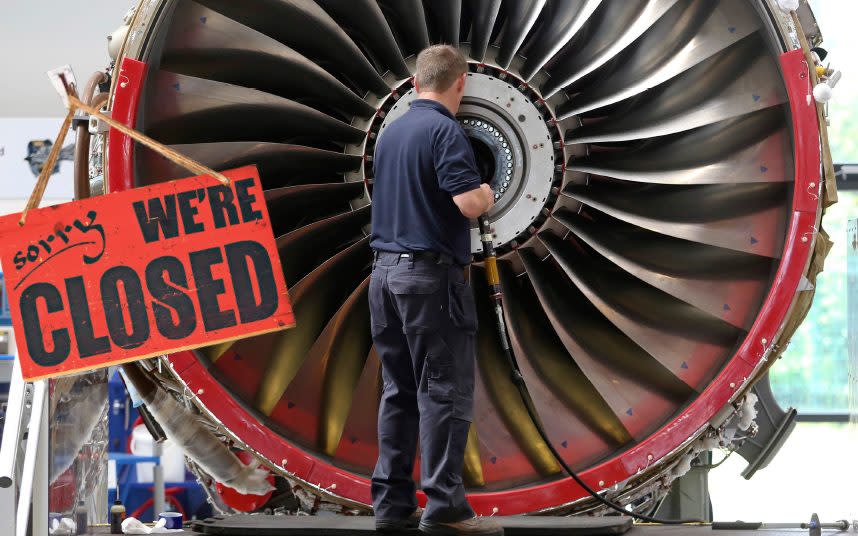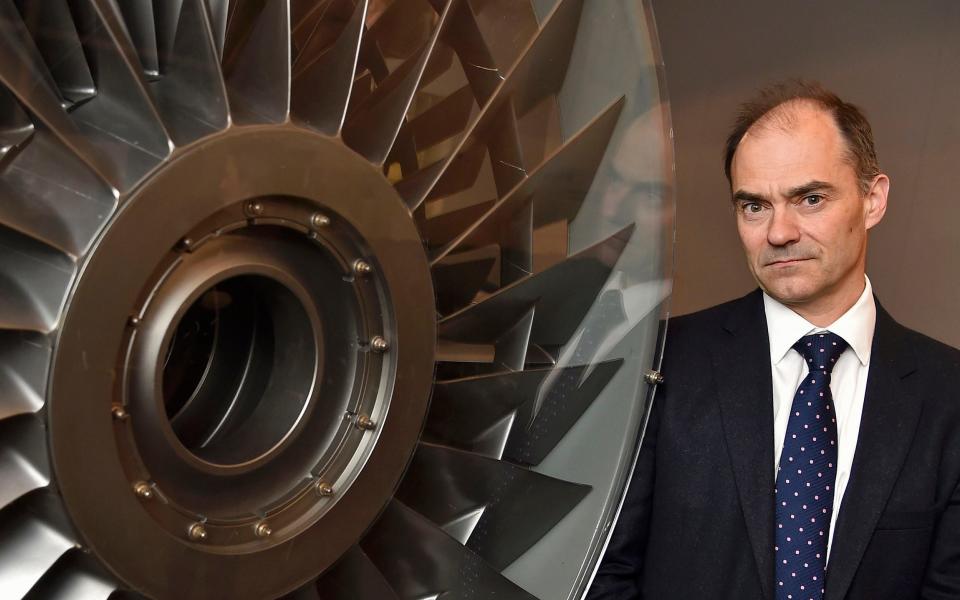Why Rolls-Royce is shutting down for a fortnight

Much of Derby’s industry has fallen silent as Rolls-Royce’s civil aerospace business begins a two-week shutdown.
The break, the first the company has had since at least the 1980s, is hoped to stem heavy losses faced by the aerospace giant since the start of the pandemic.
Coronavirus has caused a collapse in air travel, with long-haul routes serviced by the wide-body airliners hit the hardest.
On Friday, 10,000 UK staff – mostly in Derby, but also at plants in Bristol, Washington and Inchinnan – downed tools to take a fortnight’s unpaid leave.
“We will have security there, and a mini, mini, mini team to make sure that the factories are safe,” says Sebastian Resch, director of operations, who has overseen planning on how to make the closure work.
Resch will also be “off the clock” – though he says he and other executives will be checking emails a few times a day, in case of emergencies. “It’s important that we show leadership, that we are all stopping,” he says.
Worldwide, Rolls’ entire 19,000-strong civil aerospace arm – which in pre-pandemic times represented half of its £15bn annual revenues – have been taking part in similar staggered shutdowns.
Stopping work is expected to save an estimated £30m in staffing, energy and other costs. The hit to employees’ wages has been spread throughout the year to lessen the impact on pay packets.
Stopping in the right place
The process, however, has been far from straightforward. “Take a complicated part like a turbine blade from a Trent XWB,” says Resch, referring to the engine Rolls builds to power Airbus’s A350 airliners, one of the company’s biggest programmes.
“It’s cutting-edge technology, very complicated and has about 160 process steps. It has very complicated chemical processes and you need to understand where you stop them. There’s big tanks of chemicals and you may let it run because you know it’s not economical. It may also be unsafe to just shut it down.”

An engine such as the Trent XWB contains 30,000 components and Rolls produces about a quarter of them, with the rest being bought in.
The company is not the only customer for most of these suppliers, says Resch, so he expects them to keep producing, perhaps at a lower rate, building up stocks in logistics centres to be delivered when it reopens.
The likelihood of an airline desperately needing a part not already stockpiled is low because of the blow the pandemic has delivered to air travel. According to Jefferies, so far in July – normally a busy month for holiday travel – global commercial flights were at 61pc of pre-pandemic levels.
Rolls generally sells its big airliner engines at a loss, instead making money with lucrative servicing contracts. Often these are “power by the hour” deals, where the company only gets paid when an engine flies.
It’s this issue that is central to Rolls’ troubles. March’s annual results revealed a £4bn loss, and the business haemorrhaging cash, with £4.2bn flowing out. Revenues were almost £4bn lower at £11.8bn, and deliveries of large engines halved to 250, a level not expected to rise much in the near term. Part of the reason for the stand down is that, for some staff, there’s simply no work.
To bolster its finances, last summer the company announced a restructuring, cutting 15pc of its global workforce – 9,000 staff – alongside a £2bn disposal plan. It also raised more than £7bn of new debt and equity, including loans underwritten by UKEF, the Government’s export credit arm.
Savings from shutting plants and workers’ wages are a “drop in the ocean’’ when it comes to resolving Rolls’s financial issues, according to Vertical Research Partners’ Robert Stallard. He notes while fundraising means Rolls has £9bn of liquidity, it has to be paid back.
“You could argue Rolls has got liquidity so it’s not dead,” he says. “But just look at what’s happening with coronavirus. Things are not getting any better in long haul.”
At the results, chief executive Warren East says he expects large engine flying hours to be 55pc of normal levels in 2021, down from the 70pc forecast in October. He adds “the worst is behind us” but cautioned the forecast was “uncertain and highly sensitive to the developments of Covid-19”, pencilling in a return to pre-pandemic norms in 2024.
The company also revealed a “severe but plausible” scenario with flying hours at just 40pc of pre-pandemic levels in 2021 and 2022. But just two months later at the annual general meeting, flying hours were revealed to be at 40pc of 2019’s levels, “supported by cargo flights and the maintenance of key routes”.

Stallard says the latest coronavirus developments mean Rolls’ predictions are now “hopelessly outdated – everyone can see what’s happening in long-haul travel” with lockdowns, travel restrictions and people simply not wanting to risk intercontinental flights.
Interim results on August 5 may mean Rolls rebasing those forecasts, the analyst says. At the full-year numbers, the company stuck to its forecast of turning cash positive in the second half of 2021 and generating £750m in 2022.
“They’ve got a new chief financial officer,” says Stallard, referring to former Deloitte and PA Consulting executive Panos Kakoullis, who replaced Stephen Daintith in May.
Stallard adds: “Maybe a new man will be able to wind back those forecasts, saying it’ll be another big loss this year, and next year they might break even.”
Not everyone keen on the shutdown
With summer under way, some Rolls workers might be looking forward to two weeks out of the office or factory and in the sun. But despite the company working with unions to get employees to make the shutdown work, it wasn’t universally embraced.
“It was a tough decision taken in tough times,” says Tony Tinley, who worked for Rolls in Derby for 17 years before becoming a Unite regional officer. “The reality is staff have accepted it but not wholeheartedly: about 60pc voted in favour of it. That’s not a great endorsement.”
He believes the shutdown is more symbolic than financial. “It moved the needle and sent a message to the market that the workforce is ready to do what it takes to support Rolls,” Tinley says. He thinks it helped convince the Government to underwrite financial support via UKEF.
But matching resources to work is a difficult business that the shutdown might not address, he says: “Manufacturing work has always been lumpy, it’s strange when we’re seeing some people being called in for overtime now and Rolls is about to close.”
How Derby will look over the coming fortnight is unknown. But despite so many staff being employed by the famed engineer, and other companies feeding into it, there’s a sense of optimism among some.
Iain MacPherson, manager of gastropub House of Darwin near Rolls’s factories, thinks the shutdown could be good for business. “We’re just round the corner from the main site so we get lots of blue-collar Rolls staff in for a pint after work,” he says.
“Maybe with the shutdown they’ll come in in shorts and T-shirts, instead of the Rolls-Royce shirts they normally wear.”
Also hoping for a boost is Colin Wilde, managing director of Castle Rock Brewery, which runs the Alexandra Hotel in Derby. “Having thousands of people with time on their hands in Derby is fantastic,” he says. “We’re here to serve – there are certainly worse ways to spend two weeks.”

